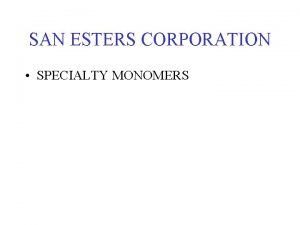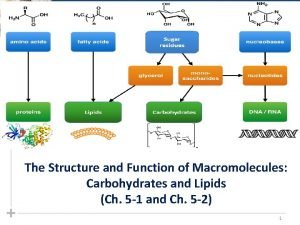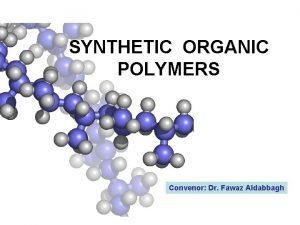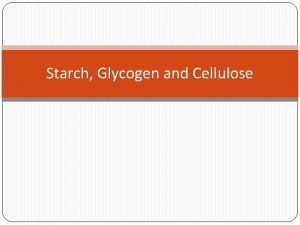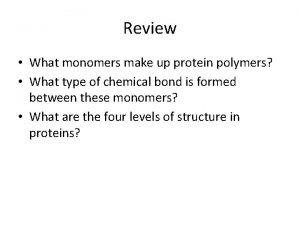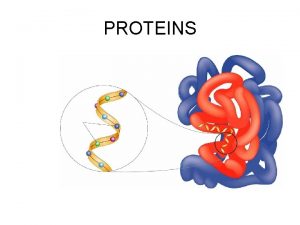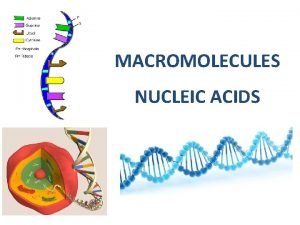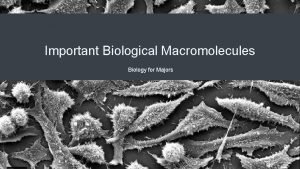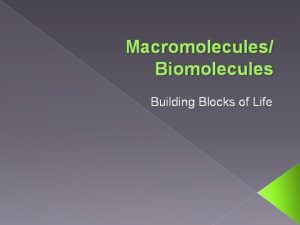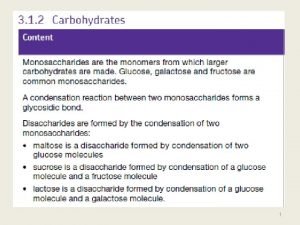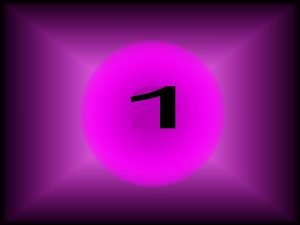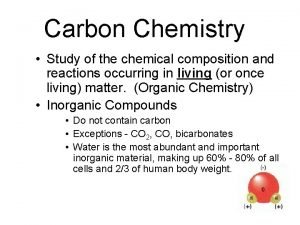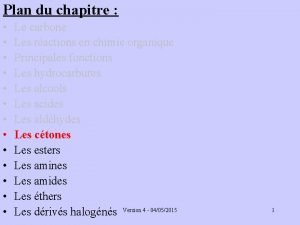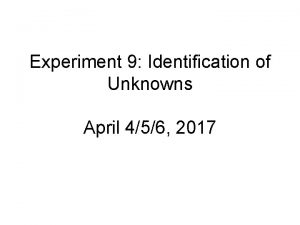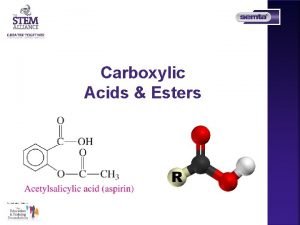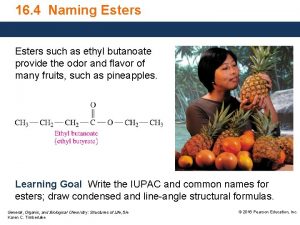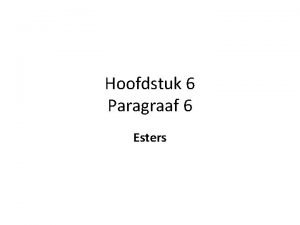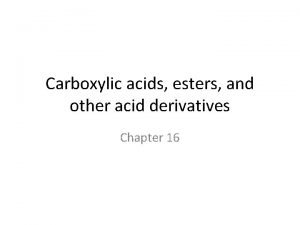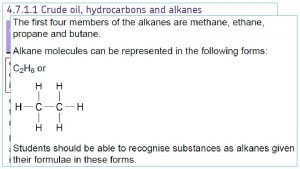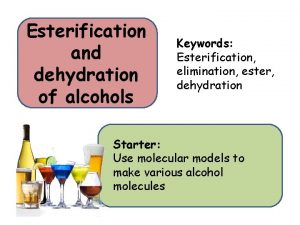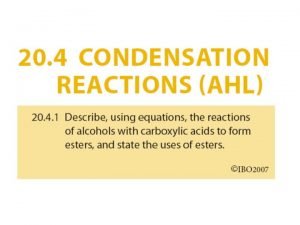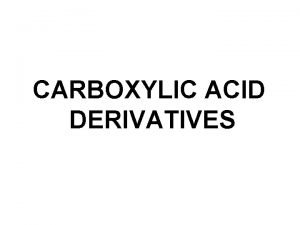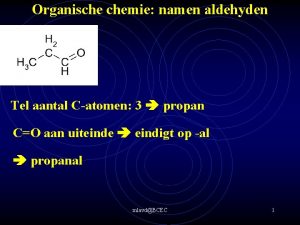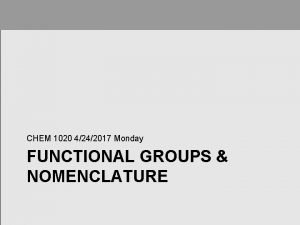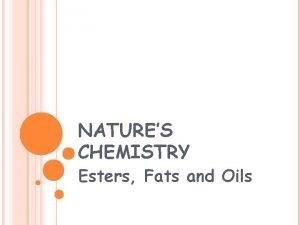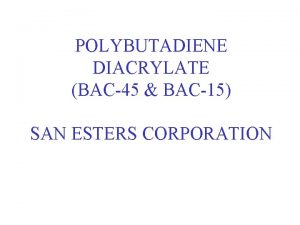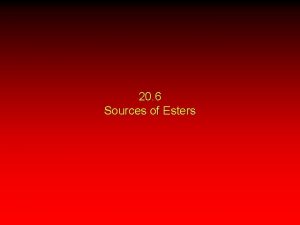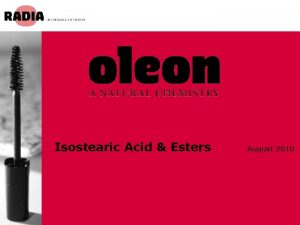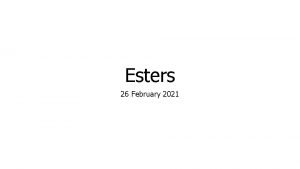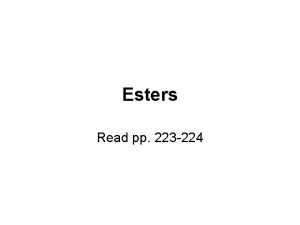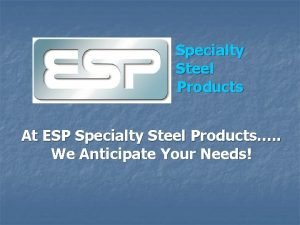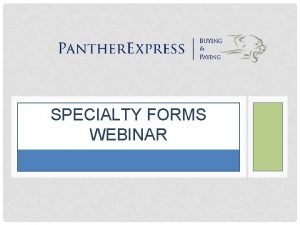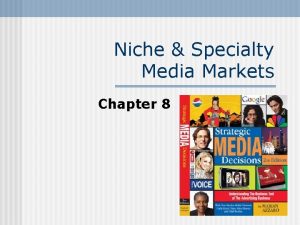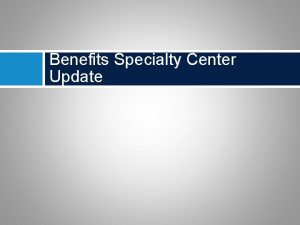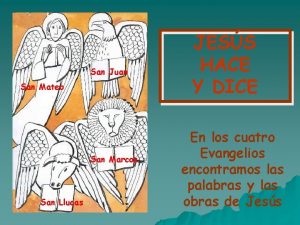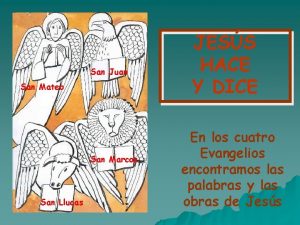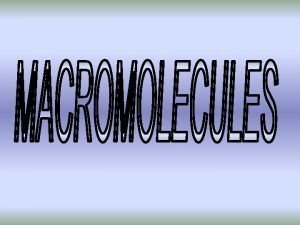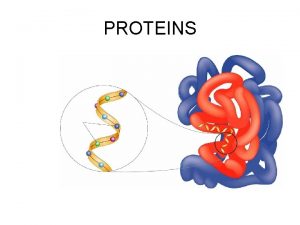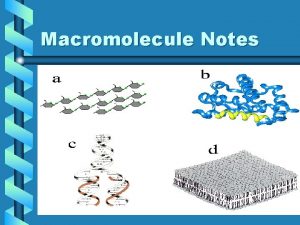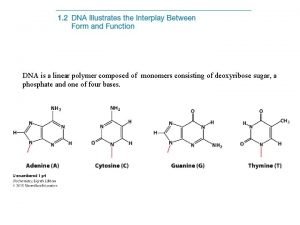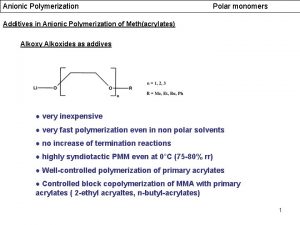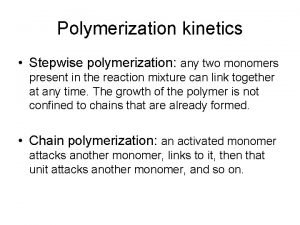SAN ESTERS CORPORATION SPECIALTY MONOMERS SAN ESTERS CORPORATION

























- Slides: 25

SAN ESTERS CORPORATION • SPECIALTY MONOMERS

SAN ESTERS CORPORATION • San Esters was formed in 1989 • Joint venture of Mitsubishi Rayon America, Osaka Organic Chemical and Kowa American • Sells and markets a wide variety of Acrylate, Methacrylate, and Acrylamide Monomers in North America

SAN ESTERS CORPORATION • Our name is derived from “San” the Japanese word for the number three, representing the 3 owners; Mitsubishi Rayon (50%), Osaka Organic Chemicals (40%) and Kowa American Corp. (10%) • “Esters” which is the predominant chemical structure of our monomers • 1 -800 -3 ESTERS (1 -800 -337 -8377)

Mitsubishi Rayon America • Mitsubishi Rayon America (MRA) is the US subsidiary of Mitsubishi Rayon Corp (MRC) • MRC is a large petrochemical, synthetic fiber and plastics producer founded in 1933 to originally produce rayon fiber • Largest producer of Methyl Methacrylate (MMA) in the world using Acetone Cyanohydrin Synthesis, Isobutylene (C 4) Oxidation, and now ethylene based ALPHA • MRC is now owned by Mitsubishi Chemical

Mitsubishi Rayon America • MMA is produced in large amounts in facories in Europe, Asia and the USA • MRC recently purchased Lucite International in 2009, almost doubling their MMA capacity • Lucite aquisition also involved obtaining Lucites new proprietary Alpha technology using ethylene as a low cost raw material. • MRC is expanding MMA capacity in China, Korea, Thailand, and potentially in the middle east.

San Esters & Mitsubishi Rayon • Mitsubishi Rayon is a major world manufacturer of specialty methacrylate esters derived from both MMA & MAA • San Esters has been supplying these specialty monomers into the USA coatings, adhesives and specialty chemical industries • MMA, Methacrylic Acid (MAA), Butyl Methacrylate (BMA), EHMA and Ethyl Methacrylate are handled by our sister company, Lucite in the USA

San Esters & Mitsubishi Rayon • Major Specialty Methacrylates include: – Glycidyl Methacrylate (GMA) – Allyl Methacrylate (AMA) – Isobornyl Methacrylate (IBXMA) – tert-Butyl Methacrylate (t. BMA) – Hydroxyethyl Methacrylate (HEMA) – Cyclohexyl Methacrylate (CHMA) – Stearyl Methacrylate (SMA) – and approximately 40 additional monomers

Glycidyl Methacrylate • Glycidyl Methacrylate is a unique monomer that allows chemists the ability to put Oxirane or Epoxy Groups into acrylic resins, thereby allowing a variety of further crosslinking or curing reactions – – Purity 98% min. Tg 46 °C Corrosive Liquid Available in drums or bulk trucks

tert-Butyl Methacrylate (TBMA) • High Tg monomer (107°C) similar to MMA (105°C), but with substantially better solubility parameter for higher solids content, lower viscosity resins and better compatibility with “leaner” oxygenated solvents • Imparts dramatic UV and moisture resistance to resins for superior gloss retention • Please see our TBMA technical brochure in download section for complete details

Isobornyl Methacrylate (IBXMA) • Isobornyl Methacrylate is a high Tg (glass transition temp. ) Monomer useful in imparting hard toughness into acrylic resins • Low color (10 APHA) and no phenothiazine inhibitor (a potent color former) allows its use in clear hardcoats • A variety of Tg have been reported from 111 °C - 175 °C • Relatively non-toxic and non-corrosive

Hydroxyethyl Methacrylate (HEMA) • HEMA is a water soluble monomer that can be used to impart Hydrophilicity into acrylic resins. Water soluble resins can be prepared or alternatively Hydrogels such as those for soft contact lenses. • HEMA can be used in solvent borne and water borne coatings. • We have a special low acidity monomer (Typically 0. 01%) – Purity 97% min. Tg 55 °C – Non-corrosive and non-toxic monomer – available in drums or bulk

Allyl Methacrylate (AMA) • Allyl Methacrylate can be polymerized into acrylic resins by group transfer polymerizations or other polymerization schemes that selectively polymerize the methacrylate double bond while leaving the Allyl group alone. • Can be used as a crosslinking monomer for a variety of acrylic and vinyl resins. • AMA is available in bulk or drums and is considered toxic by all routes of entry (also flammable) • Tg is 52 °C and purity is typically 99. 9%

Osaka Organic Chemicals • Osaka Organic Chemicals (OOC) was established in 1941 originally for the manufacture of synthetic fragrances and specialty chemicals • Produce a wide variety of specialty chemicals, solvents, photoresists, coating resins and hair care resins • OOC is a high technology company with over 20% of staff involved in research and development

San Esters & Osaka Organic • OOC’s largest product line is acrylate monomers, which San Esters offers into the US market as a natural complement to MRC’s Methacrylates – Isobornyl Acrylate (IBXA) – 4 -Hydroxybutyl Acrylate (4 HBA) – Methoxy Polyethylene Glycol Monoacrylate (MPEG Acrylate) – Stearyl Acrylate (STA) – Polybutadiene Diacrylate (BAC-45)

San Esters & Osaka Organic – tert-Butyl Acrylate (t. BA) – 2 -Hydroxyethyl Acrylate (HEA) – 2 -Ethoxyethyl Acrylate (2 ETA) – Pentaerythritol Triacrylate (PET 3 A) – Phthalic Acid & other acid function acrylates – Fluorinated Acrylates and Methacrylates – Over 100 different acrylate and methacrylate monomers

ISOBORNYL ACRYLATE (IBXA) Primarily used as a diluent monomer in radiation curable formulations to increase abrasion resistance, gloss and hardness IBXA is a low viscosity (2. 6 cps), High Tg (94 deg °C) monomer Useful in conventional coating and adhesive resins for increasing Tg where methacrylate monomers are not reactive enough Low color (< 30 APHA) and no phenothiazine (PTZ) present

TETRAHYDROFURFURYL ACRYLATE (THFA) *Low viscosity (2. 8 cps) Cyclic Ether functional Diluent monomer with excellent solvency with other monomers and oligomers *Has moderate Tg (-12 deg °C) compared to ethylene glycol ether based monomers *Highest purity (> 97%) available commercially worldwide, also results in a lower irritation index compared to competitors. Draize or primary irritation Index (P. I. I) of 5. 0 for moderate irritation allows its in UV curable formulations

ETHOXY-ETHYL ACRYLATE (EEEA) Low visocosity (2. 9 cps) , Low Tg (-67 deg °C) diluent monomer. Highest purity (over 97%) commercially available Low color and excellent wetting properties with various substrates and co-monomers. A variety of other glycol Ether monomers also available

PHENOXYETHYL ACRYLATE (PEA) Aromatic diluent monomer for uv/eb curing applications Low viscosity (3. 3 cps) and low Tg (-22 deg °C) monomer More compatible with hydrophobic and/or organophilic resins and monomers than other ether functional diluent monomers Highest purity ( > 98%) available commercially

4 -HYDROXYBUTYL ACRYLATE (4 HBA) ALSO KNOWN AS 1, 4 -BUTANEDIOL MONOACRYLATE LOW Tg HYDROXY MONOMER (-32 DEG °C) FOR INCREASED FLEXIBILITY AND SOFTNESS. CHAIN LENGTH OF PENDANT HYDROXY GROUP IN 4 HBA IS ALMOST TWICE THAT OF HEA/HPA LOW DIACRYLATE CONTENT (<. 5%) PREVENTS UNWANTED GELATION, VISCOSITY INCREASES OR CROSSLINKING HYDROXY ACRYLATE CAN BE USED AS IS IN UV/EB CURING FORMULATIONS (DRAIZE OR P. I. I. = 3. 0) OR TO END CAP SPECIALTY URETHANE OLIGOMERS

Methoxy Polyethylene Glycol Monoacrylate (MPEG 400 Acrylate or MPEG 550 Acrylate) • These monomers impart a Hydrophilic Polyethylene Glycol chain onto acrylic polymers with a low Diacrylate content. • High Diacrylate content can lead to gelation or unwanted crosslinking. • Useful for waterborne coatings and adhesives with two molecular weights to choose from: 550 or 400

Stearyl Acrylate (STA) • Stearyl Acrylate is a soft waxy monomer used to impart hydrophobicity into acrylic or other resins • The monomer melts around 30°C, so normally users would have to melt the monomer from the drums to use • Our product is almost exclusively the C 18 Ester (97% min. ) with lesser amounts of C 16 (1. 5% max) and C 20 (1. 0% max) Esters. • Useful in hydrophobic coatings (conventional and radcure), textile treatments, and release coatings

Polybutadiene Diacrylate (BAC-45) • BAC-45 is a specialty Oligomer that can impart both Elastomeric and Hydrophobicity into polymer systems. • Molecular weight is around 3, 000 and is available as a clear viscous liquid. • Non-hazardous and TSCA listed

1, 9 -Nonanediol Diacrylate (Viscoat 260) • Viscoat 260 is a new monomer that is now on TSCA • Low shrinkage and excellent crosslinking ability • Low irritancy monomer (P. I. I. = 2. 0) to replace 1, 6 -Hexanediol Diacrylate (HDDA) in UV formulations • Low viscosity (21 m. Pa*s @ 25º C) for use as a diluent monomer • Resins have excellent water resistance and good flexibility

New & Specialty Monomers • These monomer in the slide show are our most popular monomers sold in the USA • San Esters Corp. and our sister company Kowa American have access to hundreds of acrylate, methacrylate & acrylamide monomers • Please call us if you are looking for a particular monomer or physical properties in a monomer or finished resin/oligomer • Custom synthesis inquiries welcome
 Specialty monomers
Specialty monomers Importance of each biological macromolecules
Importance of each biological macromolecules Fawaz aldabbagh
Fawaz aldabbagh Starch structure
Starch structure What monomers make up protein
What monomers make up protein Monomers in proteins
Monomers in proteins The building block of nucleic acids
The building block of nucleic acids Monomers that make up proteins
Monomers that make up proteins Are monomers building blocks
Are monomers building blocks Difference between alpha and beta glucose
Difference between alpha and beta glucose Phosphate monomers
Phosphate monomers Monomer in lipids
Monomer in lipids Carboxylic acids and esters
Carboxylic acids and esters Formule générale des esters
Formule générale des esters Identification test for esters
Identification test for esters Naming esters
Naming esters Ester naming
Ester naming Formule ethaanzuur
Formule ethaanzuur Iupac naming of esters
Iupac naming of esters Ethanol
Ethanol Methanol propanoic acid
Methanol propanoic acid Carboxylic esters
Carboxylic esters In nucleophilic acyl substitution,
In nucleophilic acyl substitution, Catomen
Catomen Naming ethers
Naming ethers Specialty answering service
Specialty answering service
